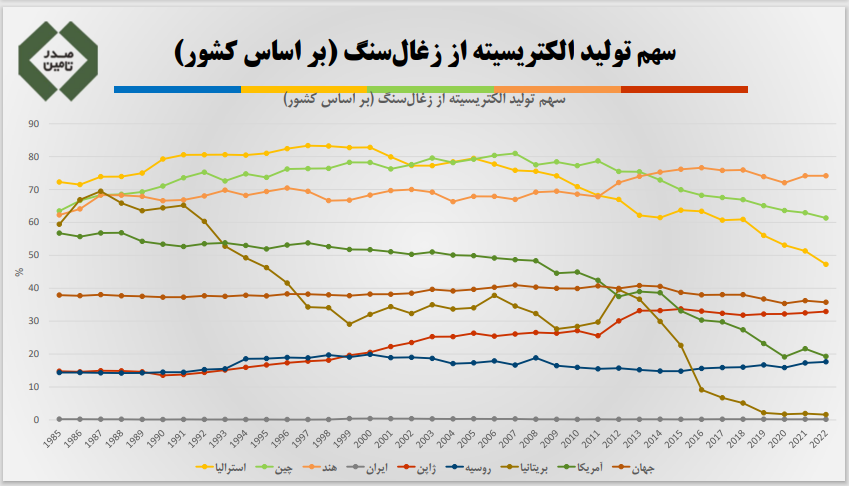Realated posts

TASSICO CEO Emphasizes the Role of Coal in World Energy Production/ Zero Share of Iran in Coal Power
Tehran- Many economies in the world rely on the coal in generation of the electricity. Investments in the extraction of this combustible black sedimentary rock as a source of energy continue in the world. However, Iran lags using coal for energy production despite having high reserves.
Managing director of Sadr Tamin Investment Company Amir-Hossein Naderi said in a specialized meeting on the role of coal in energy production in which TASSICO senior managers attended, that 36 percent of the electricity production relied on coal in the world now.
Also, 71 percent of the world’s steel production depended on this valuable material and the cement industry was another important sector supplied its energy needs from the coal, he added on Wednesday, August 23, TASSICO’s website reported.
Pointing to the share of electricity production from the coal by major countries, Naderi explained that Britain, the US and China began to decline dependency on the coal power in a period spanning 1985 to 2022 but the reliance on the coal was increased for the countries such as Japan and Turkey during the same 37 years. “Unfortunately, the coal consumption for energy production has always been zero in Iran,” he regretted.
The vice-chairman of the board of directors of TASSICO said that three billion out of 12 billion coal reserves of Iran was located in the Tabas region, pointing to the company as the largest coal player in the country.
“Our share of energy production in the field of coal is zero, and because the country has the gas energy, it has not tried to move towards coal,” Naderi stated.
Sadr Tamin CEO stressed that the share of China, America and India in the emission of CO2 stood at 4800m, 1600m and 1200m tons, respectively, and Iran ranked 9th although it had no share in the production of the electricity from the coal.
Coal, he said, could produce 1023 kilos of CO2 per megawatt hour, while the amount of CO2 emitted from the oil was around 1160 kilos, proving that the amount of oil pollution was much higher than coal.
Referring to the global energy supply productions by 2050, Naderi noted that it was expected that the energy supply would increase by 30 percent until 2050.
Meanwhile, he added that the energy consumption would reduce by five percent by the developed countries and would increase by 50 percent in the developing economies.
The International Energy Agency said that it would not be possible to reduce reliance on fossil fuels and the best proposed way was to use CCUS as the technology alone was predicted to reduce 15 percent of the total carbon emissions in the world by 2050, the managing director of TASSICO explained.
Carbon Capture, Usage and Storage (CCUS) technology can capture and make effective use of the high concentrations of CO₂ emitted by industrial activities.
The CEO noted that the company was looking for finding the coal chain, and if it could not be implemented in the country, Iran must have thorough control on it and find out which direction the world had gone and was going.
Naderi stated that the main objective of the decrease in the coal consumption was to prevent the emission of greenhouse gases, which caused the earth warming. He added that investment in the coal industry, using coals of better quality, improving efficient production and trapping the emitted gases could contribute to the emission of these gases more.
The vice-chairman of the board of directors of Sadr Tamin Investment Company referred to the conversion of coal to gas in mines, saying that a lot of work should be done in this field.
“When we say that knowledge-based work must be done, we mean such issues,” Naderi stressed. “These works are accessible in the system from the beginning to the end, but we have to admit that we do not have the knowledge of it. In such cases, we must employ the capacity of the academic elites and Sadr Farda accelerator.”
Naderi emphasized that the world was extracting methanol from the coal, which was more economical, adding that the country’s biggest methanol factories had been closed due to the increase in gas prices.
Therefore, the CEO said, the company could seize the opportunity to set up a plant to extract methanol from the coal with the cooperation of Tamin Petroleum & Petrochemical Investment Company (TAPPICO), using the available capacity.
Coal could also be used in the cement industry, he stressed. The production of the cement in the world stood at 4b tons, of which Iran’s share was 60m tons, the official added, explaining that 90 percent of the energy used in the cement industry in the world were from the coal, but there were no coal-based cement plants in Iran.
He called on the industries to raise the issue for the academic community, noting that TASSICO was to supply coal to build a coal-based cement factory and must invite talents to work on the issue.
Naderi further stated that there were lots of rooms for working on sponge coke and green coke and middle coke. “We must shift the energy path of the country from the gas and electricity to the coal and use the coal capacity to produce energy,” he said and added, “Also, many projects have been outlined in different coal sectors because the coal mining has become profitable in the country with the increase in coal prices.”
The chief executive referred to the coal consumption figures in the world, adding that the coal consumption was increased by 8.8 percent in China, 8.3 percent in India, 52 percent in Indonesia, 2.3 percent in the European Union, 3.5 percent in Germany, 3.2 percent in Turkey and 48 percent in Italy in 2021 compared to those in 2022.
“The coal consumption in Iran is very low compared to the [consumptions] of the neighboring countries such as Pakistan, Qatar, UAE, Turkey, etc., and this is a disaster considering the reserves that we have,” he concluded.


